Chris Riley tests the 2021 Mazda BT-50 XTR 4×4 dual cab ute with pricing, specs, ride and handling, safety, verdict and everything the over-50 driver needs to know.
Summary: Chris Riley acknowledges that the new Mazda BT-50 is “a good thing”, but wonders if Mazda has done enough.
2021 Mazda BT-50 XTR 4×4 dual cab ute
Pricing: $57,210 (plus on road costs).
Warranty: Five-years, unlimited km
Safety: 5-star ANCAP
Engine: 3-litre four-cylinder inline diesel engine
Power: 140kW at 3600rpm
Torque: 450Nm at 1600-2600rpm
Transmission: six-speed automatic
Drive: 4×4
Body: 5280mm (long); 1870mm (wide); 1785mm (high)
Ground clearance: 240mm
Weight: 2030kg
Towing capacity: 3500kg
Wheels: 18-inch alloy (XTR)
Tyres: 265/60 R18
Turning circle: 12.5m
Fuel tank: 76 litres
Thirst: 8.0L/100km (combined, diesel)
Consumption on test: 7.8L/100km
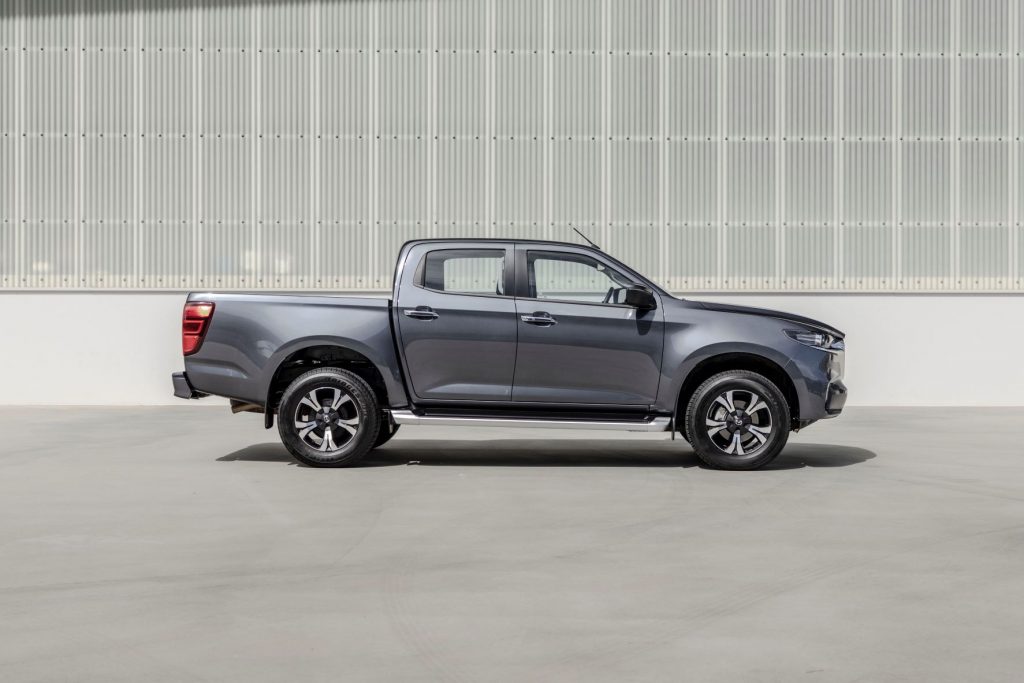
[review]
For ute watchers, Mazda’s BT-50 has more in common with the Isuzu D-Max than it does the Ford Ranger these days.
After they parted ways, Mazda did a deal with Isuzu while Volkswagen went looking for something to turn into the next Amarok.
For its part Mazda reportedly had little input into the design process and as a result BT-50 is simply a reskinned version of D-Max, although that’s probably a little harsh.
To put this in perspective, Isuzu has enjoyed meteoric success with the latest D-Max, which has stormed the top sellers list, providing a solid launching pad for Mazda — the real question is whether it has done enough?
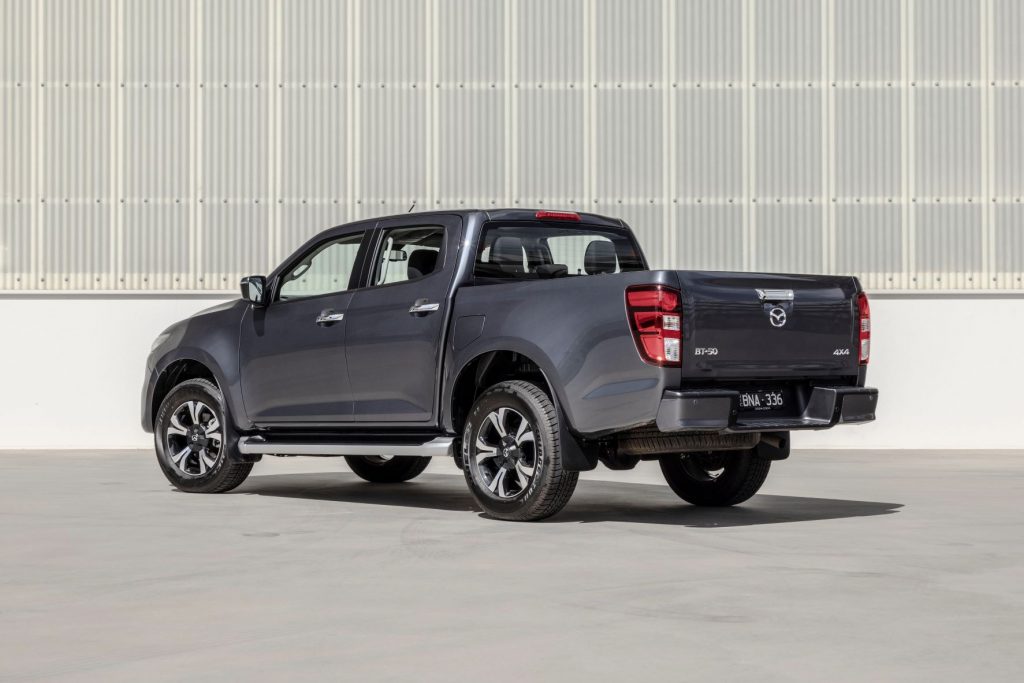
STYLING
The new BT-50 looks more refined and car-like — a bit like the last Falcon in fact.
From the rear however the look is generic ute, with vertical tail lights replacing the stylised triangular of the previous model.
The ‘ruggedly stylish’ XTR 4×2 with an auto is $49,470, XTR 4×4 with a manual is $54,710 and the 4×4 auto is $57,210 — all prices before on-road costs.
Standard kit includes 17-inch alloys, cloth trim and manual air, carpeted floors, power windows, power adjust mirrors, LED headlights, auto lights and wipers, rear parking sensors, adaptive cruise control, automatic high beam and traffic sign recognition and walk away automatic locking.
XTR adds 18-inch alloys, side steps, power fold mirrors, advanced keyless entry and push-button start, LED fog lights, LED headlights with auto levelling, LED daytime running lights, dual-zone climate air with rear vents, leather wrapped steering wheel and gear knob, auto-dimming rear view mirror and centre armrest for the rear seat.
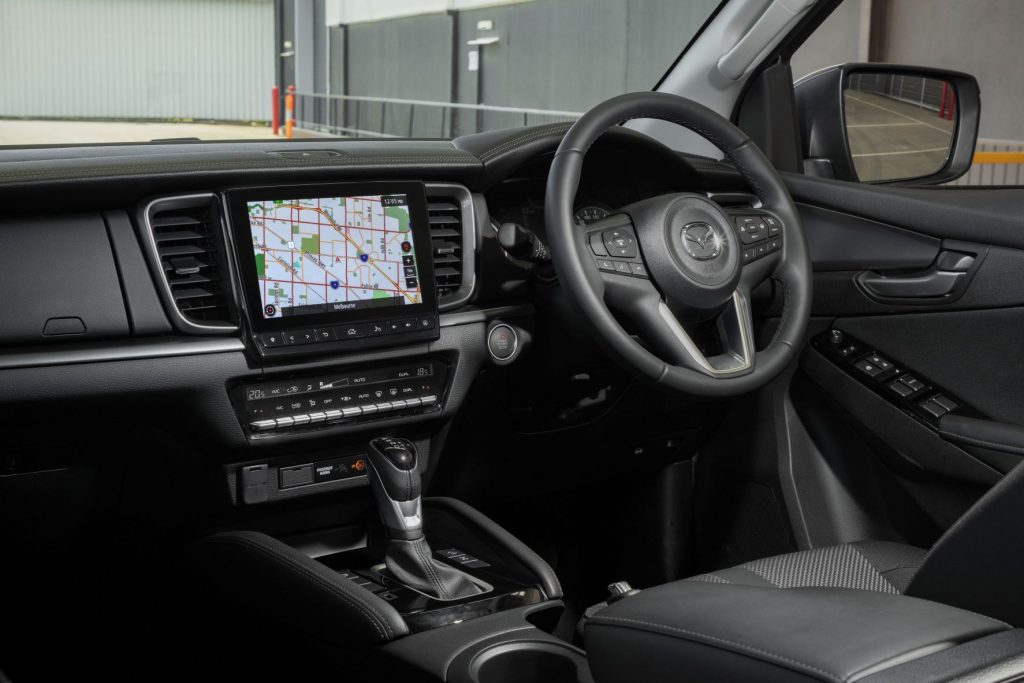
INTERIOR
The cabin is trimmed in cloth with dual zone climate air conditioning, rear air vents for back seat passengers and a splash of leather for the wheel and transmission lever.
Style-wise the main difference between BT-50 and the D-Max is the centre console which has higher sides in the Mazda to prevent items from falling out.
The wheel is reach and height adjustable, while the seats have manual adjustment for rake, slide, height and lumbar support.
The screen, unlike other Mazdas, is touch sensitive, with no central control knob (but no volume control knob either).
Analogue instrument gauges flank a central info screen where speed can be displayed digitally, and traffic sign recognition keeps the driver informed of the current speed limit.
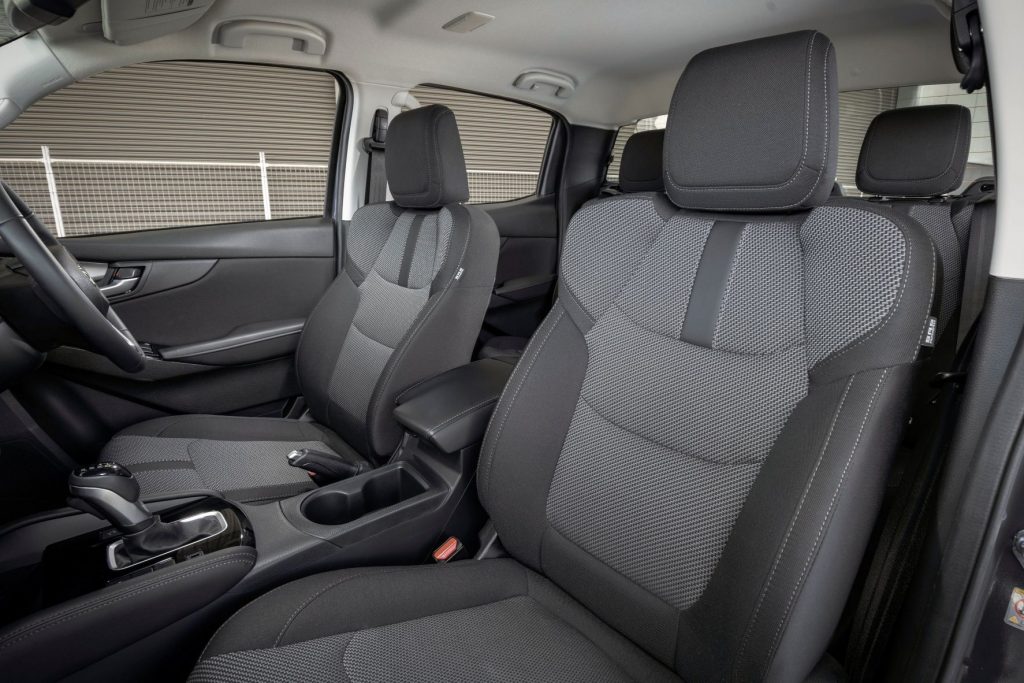
INFOTAINMENT
The infotainment system comprises a 7.0-inch touchscreen and two-speaker audio with Bluetooth streaming, AM/FM and DAB+ digital radio, Android Auto and Wireless Apple CarPlay — plus single USB and 12V outlets.
In the XTR this is upped to a 9.0-inch touchscreen with eight speakers and satellite navigation.
A new speaker is mounted in the headlining, while a 6 x 9-inch woofer delivers powerful bass response and two-way dome tweeters emit clear mid- to high-range sounds.
Dash-mounted and rear door ‘balanced dome’ tweeters use a voice coil and dome-shaped diaphragm to create impressive depth.
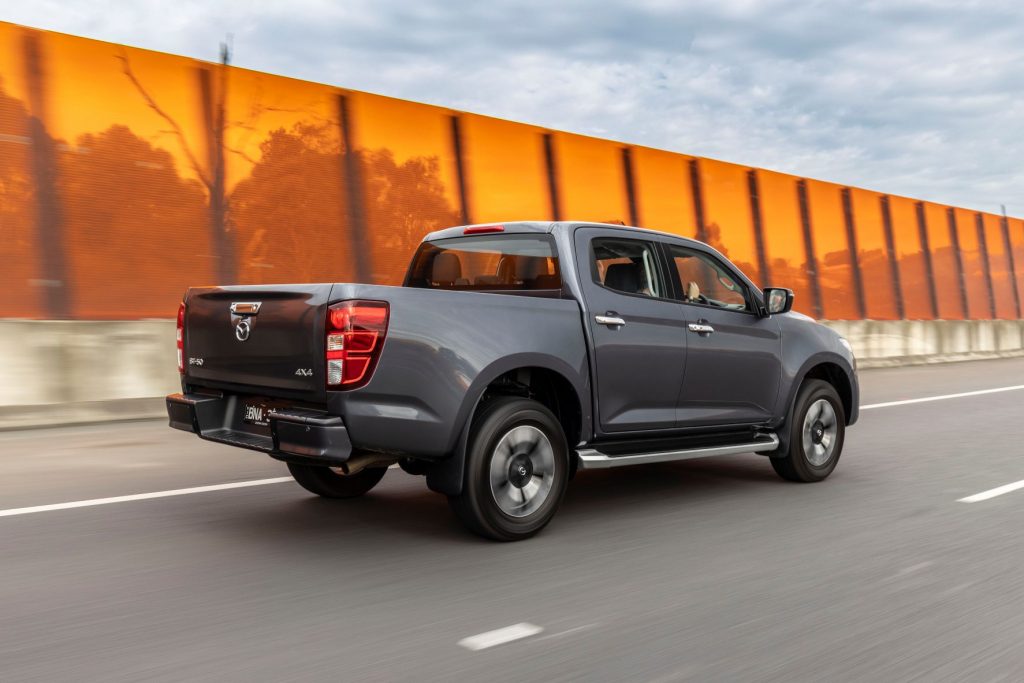
ENGINES / TRANSMISSIONS
BT-50 is powered by a turbocharged 3.0-litre, four-cylinder diesel engine that generates 140kW of power and 450Nm of torque, the latter between 1600 and 2600 rpm.
It replaces the previous 3.2-litre five-cylinder unit that generated 147kW and 470Nm, torque from a low 1750 revs.
The new power plant features an aluminium-alloy head and cast-iron engine block, chain-driven double overhead camshafts, four valves per cylinder, drive-by-wire throttle control and a Variable Geometry System (VGS) turbocharger.
Two-wheel drive models all get a 6-speed auto, while the 4×4 version is offered with a choice of 6-speed manual or automatic.
You can change gears manually using the shifter with the auto, but steering wheel mounted change paddles are not provided.
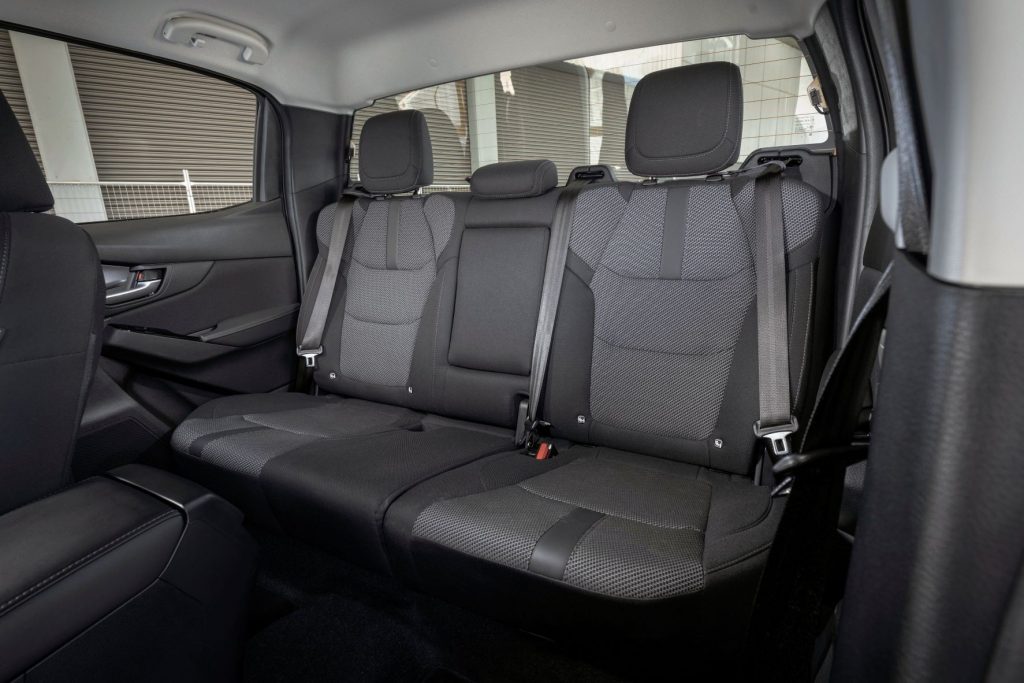
SAFETY
An extensive, five-star safety package includes eight airbags, reverse camera and Autonomous Emergency Braking.
There’s also Attention Assist, Blind Spot Monitor, Emergency Lane Keeping Assist – Overtaking, Emergency Stop Signal, Automatic High Beam, Hill Descent Control, Hill Launch Assist, Lane Departure Warning, Lane Departure Prevention, Lane-keep Assist System (automatic models), Locking Rear Differential (4×4 models), Rear Cross Traffic Alert, Roll Over Protection, Secondary Collision Reduction, Speed Assist System, Traction Control System and Turn Assist.
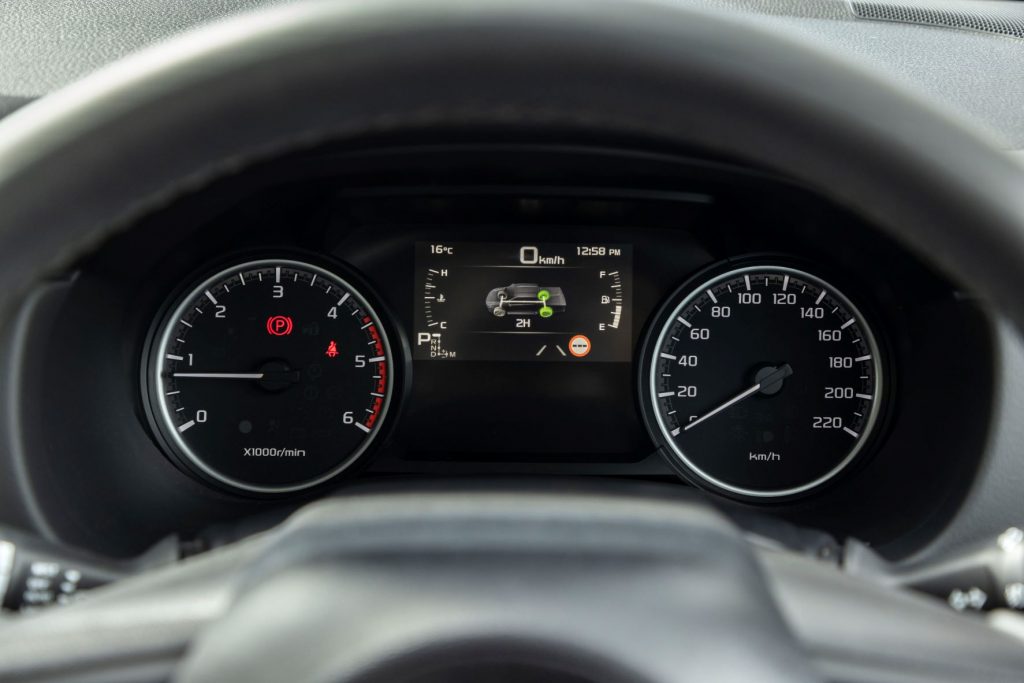
DRIVING
The drive experience is slow, heavy and truck-like overall.
Depending on what you’re looking for, this may not be as bad as it sounds.
On a more positive note, it’s a relaxed, easy vehicle to drive that cruises effortlessly and uses hardly any fuel for a vehicle this size.
You’ve gotta like that.
Mazda reveals the new BT-50 weighs up to 50kg less than the previous Ford-based model.
The old 3.2-litre five cylinder with an auto used 10.0L/100km, while this one uses up to 20 percent less at a claimed 8.0L/100km.
With a 76-litre tank, we were getting 7.8L after more than 500km.
Front suspension is independent via upper and lower wishbones with coil springs, gas-filled telescopic dampers and a stabiliser bar.
For the rear a semi-elliptic leaf with alloy-steel spring leaves and gas-filled telescopic dampers ensure maximum reliability and car-like ride and handling qualities.
Speed-sensitive, power-assisted rack and pinion steering is standard across the range, with 3.84 turns to lock
The switch to 4×4 is via a rotary knob located in the lower part of the console, with high and low range available — as well as a locking rear differential with the auto.
This model has decent ground clearance of 240mm and can handle an impressive 800mm of water, but we worry about the side steps which are almost guaranteed to be dented off road.
All grades and body types are fitted with under-body protection to guard against accidental damage off-road or in rural areas.
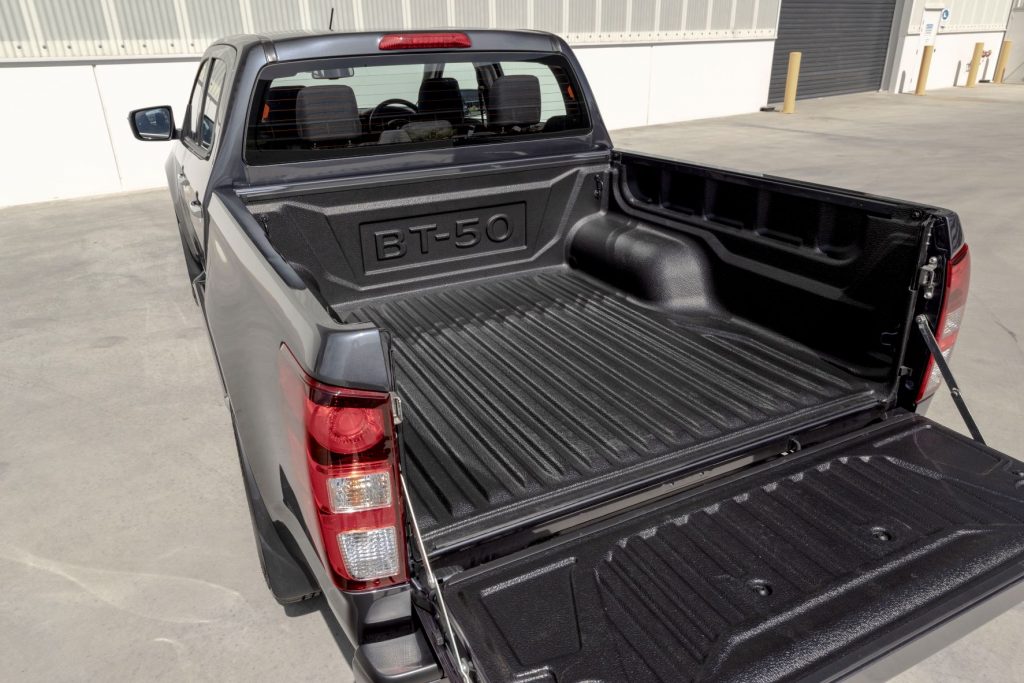
XTR can carry a 1090kg payload and pull a 3500kg braked trailer.
The cargo box is 1571mm long, 1530mm wide and 490mm deep, with 1120mm between the wheel arches and four tie-down points.
Our test vehicle had a tray liner, but the liner is optional.
There are two ISOFIX and two top tether child seat anchor points.
Servicing intervals are 12 months or 15,000km and it comes with a five-year unlimited kilometre warranty.
SUMMING UP
BT-50 ticks all the right boxes. It’s a fine ute and certainly fit for purpose.
But still looks too refined and car-like. Too much like a Falcon in fact and look what happened to it.
Ranger on the other has delivered incredible sales results largely on the back of its blunt, chiselled macho styling and carefully crafted ‘tough as nails’ image.
Plenty of black trim helps too. That’s, demonstrably, is what buyers want and that’s what Mazda needs to provide — it’s not rocket science guys.
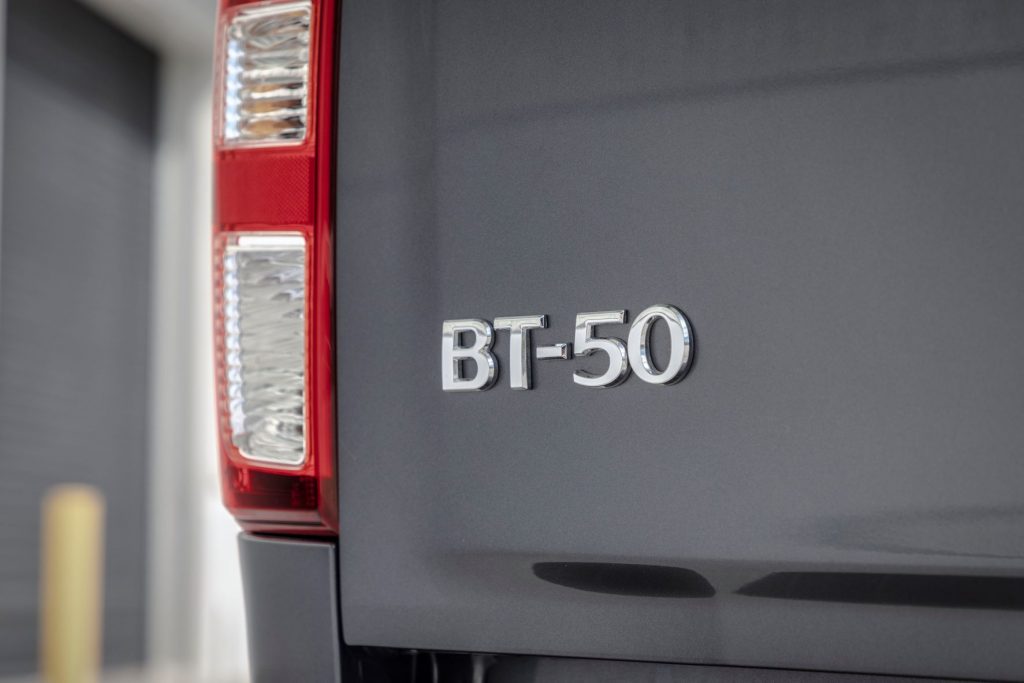 RATINGS (out of 10)
RATINGS (out of 10)
- Looks – 7.5
- Performance – 7.5
- Safety – 8
- Thirst – 8
- Practicality – 7.5
- Comfort – 7.5
- Tech – 8
- Value – 8
- Overall – 7.75
AT A GLANCE
XTR Dual Cab Pickup (auto) $57,210
This review was prepared by Chris Riley and first appeared on cars4starters, https://cars4starters.com.au/
seniordriveraus comments
Chris makes a good point (as usual) when he asks if the new Mazda BT-50 is up to the task of tackling the big hitters in the class.
Crew cab utes have come a long way in recent years, driven as much by their appeal to families as by their more traditional role of tradie workhorse.
Many older drivers were quick to catch on that a crew cab ute made an ideal tow vehicle for the Great Circumnavigation and many BT-50s have been bought by the over-50s.
The first question many of them will ask about the new one is: “Is it a better option than the Isuzu D-Max on which it is based?”
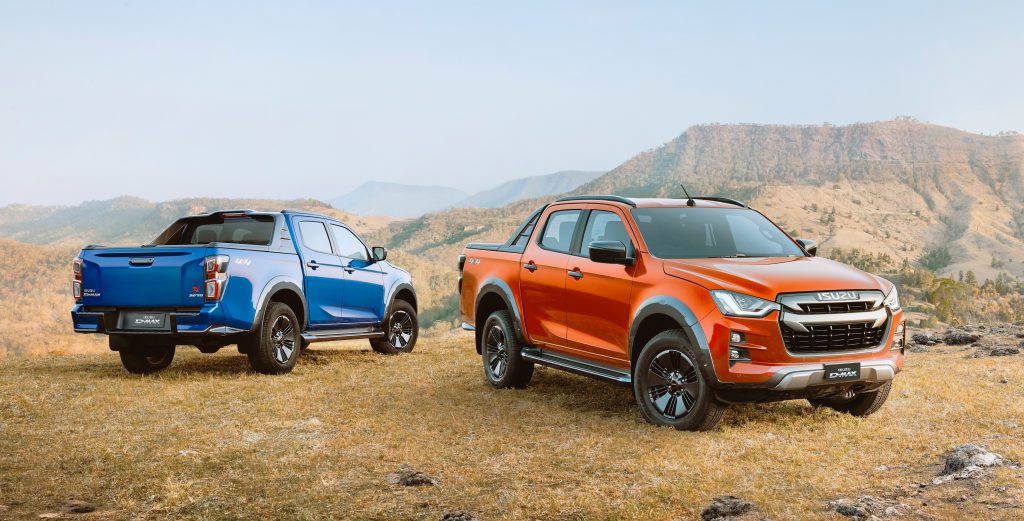
Judging by the way the Isuzu has leapt up the sales charts, it may appear not, especially since the new D-Max is such a quantum leap over the model it replaces. When we drove the Isuzu, its new levels of refinement, higher equipment levels and neater design impressed us, and most people who saw it.
One of the considerations for many over-50 BT-50 buyers will be the change of engine from the previous tough-as-old-boots 3.2-litre five-cylinder. The new motor drops 7kW and 20Nm perhaps not much in real terms but possibly a deal-breaker for people looking at towing.
The trade-off, of course, is 20 percent improved fuel consumption.
As for Chris’ observation that the new BT-50 bears an unfortunate similarity to the Falcon … it’s not something we noticed until he pointed it out.
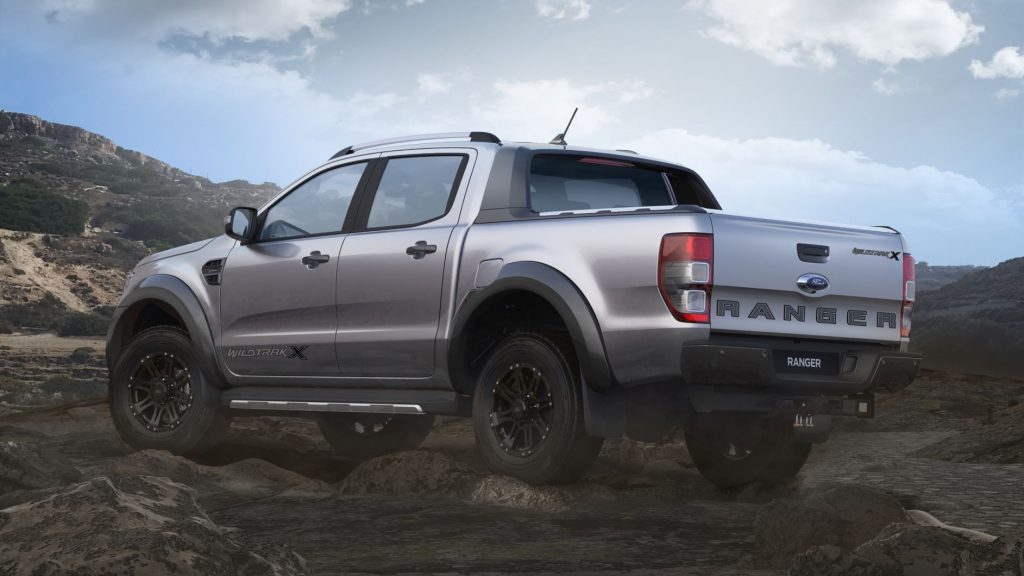
Another strong contender for your money will be the Ford Ranger XLT (the BT-50 XTR and Isuzu D-Max LS-U are priced within $700 of each other; the Ranger XLT Pickup Double Cab is more expensive at $59,690, but is also bigger all ‘round, although it handles a smaller payload – 1070kg for the Mazda, 1055kg for the Isuzu but just 970kg for the Ranger). The Ranger is thirstier, too, at 8.9L/100km. And a new model is on the horizon (scheduled to arrive November 24, read our report here), so you may be able to haggle the price down on the outgoing model.
Another factor to consider is the Isuzu 6-year/150,000km warranty (the others get five years, but unlimited km). And less supple buyers need to consider the difficulty of climbing up into the cab (worse with the Ranger, because it’s even higher). And like all utes, security for anything stored in the tub is minimal, so factor in buying a hard cover.
But it’s clear that ute buyers are getting a better deal as the contenders fight for market share. And that can’t be all bad.
